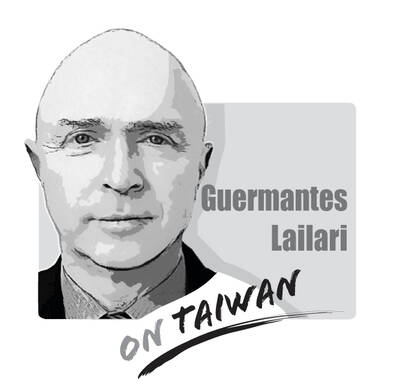During a speech on Saturday last week at a discussion forum titled “Resume cross-strait air travel: post-pandemic opportunity,” former president Ma Ying-jeou (馬英九) said that the Democratic Progressive Party (DPP) had criticized him for being pro-China and “selling out” Taiwan.
Paradoxically, instead of reducing reliance on China, the government had increased Taiwan’s dependence on it, Ma said, adding that Taiwanese exports to China last year reached a historic high. This shows that President Tsai Ing-wen’s (蔡英文) administration is more pro-China and has “sold out” Taiwan to a greater degree than he had, Ma said.
However, according to a report published last year, relying on trade volume alone is insufficient to demonstrate an increased dependence on China’s economy.
In a Jan. 4 article in the Liberty Times (the Taipei Times’ sister paper), I showed that Taiwan’s record exports to China was a side effect of US restrictions on the export of technology to China and supply chains relocating as a result of the trade dispute. China has been forced to purchase large quantities of semiconductor and electronic components from Taiwan.
In other words, far from demonstrating Taiwan’s increased reliance on China, last year’s record exports showed that China needs Taiwan. Data released by the Ministry of Economic Affairs has also poured cold water on Ma’s claim, pointing out that the whole world relies on Taiwanese chips.
Ma also said that the US and European countries are increasingly concerned that a conflict between China and Taiwan could break out within the next six years. Ma sought to pin the blame for this entirely on the shoulders of Tsai, and called on her to return to the so-called “1992 consensus” so that dialogue between Taipei and Beijing could resume.
Ma appears to have forgotten that during his tenure as Mainland Affairs Council deputy minister, he wrote an article for the Chinese Nationalist Party’s (KMT) official newspaper Central Daily News, published on Nov. 6, 1992, which contained the following frank admission: “China’s Association for Relations Across the Taiwan Straits (ARATS) is well aware that both sides have different formulations for ‘one China’ and that there is no convergence. Despite this, Beijing constantly puts it about that both sides have reached a consensus.”
Ma’s “one China, each side with its own interpretation” formula, which enjoys a sacred status within the KMT, was dashed by former ARATS vice chairman Tang Shubei (唐樹備) when he in 1998 said that the “Taiwan side’s so-called one China formula is unconnected to reality.”
If that were not conclusive enough, Chinese President Xi Jinping (習近平) hammered the final nail in the coffin in a speech on Jan. 2 last year to mark the 40th anniversary of China’s “Message to Compatriots in Taiwan.”
Xi in his “five points” proposed to create a “Taiwanese version of the one country, two systems framework.”
This included a redefinition of the “1992 consensus” to mean that “both sides of the Strait belong to one China and will work jointly to seek national unification on the ‘one China’ principle.”
Not only is there no consensus over the “consensus,” Xi has redefined the mythical meeting of minds as a manifesto for unification with China.
It is utterly baffling why Ma continues to parrot China’s Taiwan Affairs Office propaganda, cherry-pick economic data and distort the truth about the “1992 consensus.”
Why does a former president persist in coordinating with Beijing to sow confusion among the public?
Liou Je-wei is a student at National Taiwan University’s Graduate Institute of Political Science.
Translated by Edward Jones

Chinese state-owned companies COSCO Shipping Corporation and China Merchants have a 30 percent stake in Kaohsiung Port’s Kao Ming Container Terminal (Terminal No. 6) and COSCO leases Berths 65 and 66. It is extremely dangerous to allow Chinese companies or state-owned companies to operate critical infrastructure. Deterrence theorists are familiar with the concepts of deterrence “by punishment” and “by denial.” Deterrence by punishment threatens an aggressor with prohibitive costs (like retaliation or sanctions) that outweigh the benefits of their action, while deterrence by denial aims to make an attack so difficult that it becomes pointless. Elbridge Colby, currently serving as the Under
The Ministry of the Interior on Thursday last week said it ordered Internet service providers to block access to Chinese social media platform Xiaohongshu (小紅書, also known as RedNote in English) for a year, citing security risks and more than 1,700 alleged fraud cases on the platform since last year. The order took effect immediately, abruptly affecting more than 3 million users in Taiwan, and sparked discussions among politicians, online influencers and the public. The platform is often described as China’s version of Instagram or Pinterest, combining visual social media with e-commerce, and its users are predominantly young urban women,
Most Hong Kongers ignored the elections for its Legislative Council (LegCo) in 2021 and did so once again on Sunday. Unlike in 2021, moderate democrats who pledged their allegiance to Beijing were absent from the ballots this year. The electoral system overhaul is apparent revenge by Beijing for the democracy movement. On Sunday, the Hong Kong “patriots-only” election of the LegCo had a record-low turnout in the five geographical constituencies, with only 1.3 million people casting their ballots on the only seats that most Hong Kongers are eligible to vote for. Blank and invalid votes were up 50 percent from the previous
Japanese Prime Minister Sanae Takaichi lit a fuse the moment she declared that trouble for Taiwan means trouble for Japan. Beijing roared, Tokyo braced and like a plot twist nobody expected that early in the story, US President Donald Trump suddenly picked up the phone to talk to her. For a man who normally prefers to keep Asia guessing, the move itself was striking. What followed was even more intriguing. No one outside the room knows the exact phrasing, the tone or the diplomatic eyebrow raises exchanged, but the broad takeaway circulating among people familiar with the call was this: Trump did